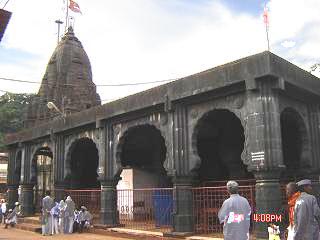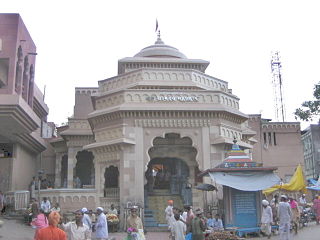
Bhimashankar Temple is a Hindu temple dedicated to Shiva situated in its eponymous village, Bhimashankar, in Pune district of Maharashtra. It is a key pilgrimage centre and contains one of the 12 Jyotirlingas. The temple's Shiva lingam is one of the three Jyotirlingas of Maharashtra. The mandir is situated on a mountain, 110 kilometers away from Pune. The temple's vicinity has rare plant and animal species. The mandir is located in Khed taluka, in the Bhimashankar forest range.

Harishchandra Fort is a hill fort in the Ahilyanagar(Ahmednagar) district of India. Its history is linked with that of Malshej Ghat, Kothale village and it has played a role in guarding and controlling the surrounding region.

Pandharpur is a popular pilgrimage town, on the banks of Chandrabhagā River, near Solapur city in Solapur District, Maharashtra, India. Its administrative area is one of eleven tehsils in the District, and it is an electoral constituency of the state legislative assembly. The Vithoba temple attracts about a million Hindu pilgrims during the major yātrā (pilgrimage) in Ashadha (June–July).

The Bhima River is a major river in Western and South India. It flows southeast for 861 kilometres (535 mi) through Maharashtra, Karnataka, and Telangana states, before joining the Krishna River. After the first sixty-five kilometers in a narrow valley through rugged terrain, the banks open up and form a fertile agricultural area which is densely populated.

Pune district is a district in Western Maharashtra with Administrative Headquarters in Pune city. Pune district is the most populous district in the Indian state of Maharashtra. It is one of the most industrialised districts in India.

Shivaram Hari Rajguru was an Indian independence activist from Maharashtra, known mainly for his involvement in the assassination of a British police officer named John Saunders. He was an active member of the Hindustan Socialist Republican Association (HSRA) and on 23rd March 1931, he was hanged by the British government along with his associates Bhagat Singh and Sukhdev Thapar.

Bhandardara is a holiday resort village near Igatpuri, in the western ghats of India. The village is located in the Akole tehsil, Ahmednagar district of the state of Maharashtra, about 185 kilometers (115 mi) from Mumbai, 155 kilometers (96 mi) from Ahmednagar and 73 kilometers (45 mi) from Nashik.
Daund is a city, municipal council, and headquarters of the Daund tehsil in the Pune district in the state of Maharashtra, India. The city of Daund is located on the Bhima River.
Rajgurunagar, formerly known as Khed is a census town in the Pune Metropolitan Region of the Indian state of Maharashtra. It is situated on the bank of the Bhima River and on the Pune-Nasik National Highway. It is the headquarters of Khed taluka in the Pune district. Rajgurunagar is about 10 km from Chakan.

Maharashtra attracts tourists from other Indian states and foreign countries. It was the second most visited Indian state by foreigners and fifth most visited state by domestic tourists in the country in 2021. Aurangabad is the tourism capital of Maharashtra.

Ujjani Dam, also known as Bhima Dam or Bhima Irrigation Project, on the Bhima River, a tributary of the Krishna River, is an earthfill cum Masonry gravity dam located near Ujjani village of Madha Taluk in Solapur district of the state of Maharashtra in India.
Narayangad is a fort in Pune district near to khodad-Gadachiwadi in the Indian state of Maharashtra.

Ambegaon taluka is a taluka in Shirur subdivision of Pune district of state of Maharashtra in India. One of the twelve most revered Shiva temples or Jyotirlinga, the Bhimashankar Temple is in Khed taluka. But due to Bhimashankar Sanctuary, the road is through Ambegaon taluka.

Ghod River is located in Pune District, Maharashtra, western India. It is a tributary of the Bhima River. The Ghod originates on the eastern slopes of the Western Ghats at 1,090 metres (3,580 ft) above sea level. It flows in an east-southeast direction for approximately 200 kilometres (120 mi) before its confluence with the Bhima. It flows from the northern side of the Sahyadri Hills.
Pimpalgaon Tarf Khed is a panchayat village in the state of Maharashtra, India, on the left (east) bank of the Bhima River. Administratively, Pimpalgaon Tarf Khed is under Khed Taluka of Pune District in Maharashtra. The village is 11 km east of the town of Chakan, and 23 km by road south of the town of Rajgurunagar (Khed).

Bhimashankar Jyotirlinga (Dakinyam), Bhimpur, is a Hindu temple situated in the western part of the holy Mahendragiri mountains on the Mahendratanaya River in the Indian state of Odisha. It is debated to be the Dakini area and the Jyotirlingam found there is believed to be one among the 12 Jyotirlingams.

Shri Laxmi Narsimha Temple is a Hindu temple dedicated to Narasimha, an avatar of Vishnu, located in western India, in Pune district of the state of Maharashtra. The temple is located at the confluence of Bhima river and Nira river, at the south eastern tip of Pune district, in Indapur taluka.
The Chaskaman Dam is one of the important dams of Maharashtra and is built on the Bhima River at Rajgurunagar in Pune district. It is located across river Bhima in Krishna basin near Village Bibi in Khed taluka. The main purpose of this dam was to improve irrigation and supply of electricity to the nearby villages. It is the second Hydel Greenfield power project in the country that is capable of captive power as well. The power will be utilized through the state power board. The project was completed during 2008-09.
The Pune–Nasik railway line is a proposed higher speed railway between the cities of Pune and Nashik. The project will allow trains to cover the 235.5 km route in around two hours at speeds of up to 200 km/h, including future-proofing for 250 km/h.














